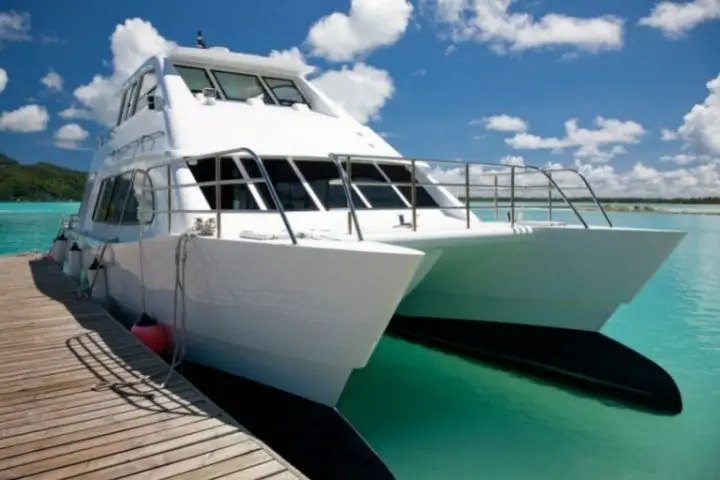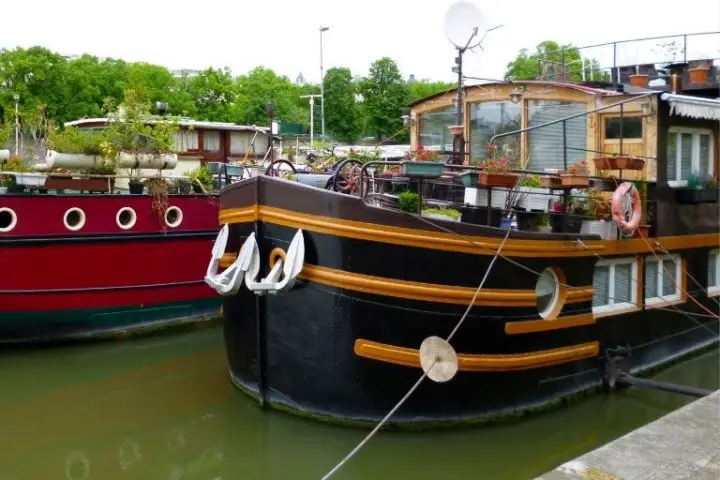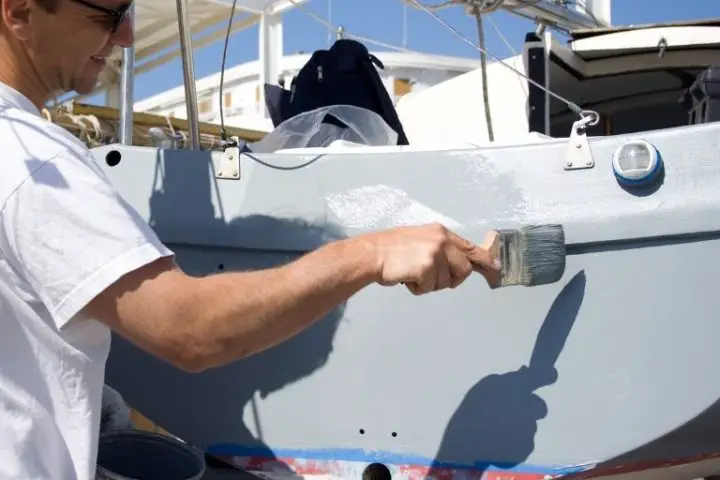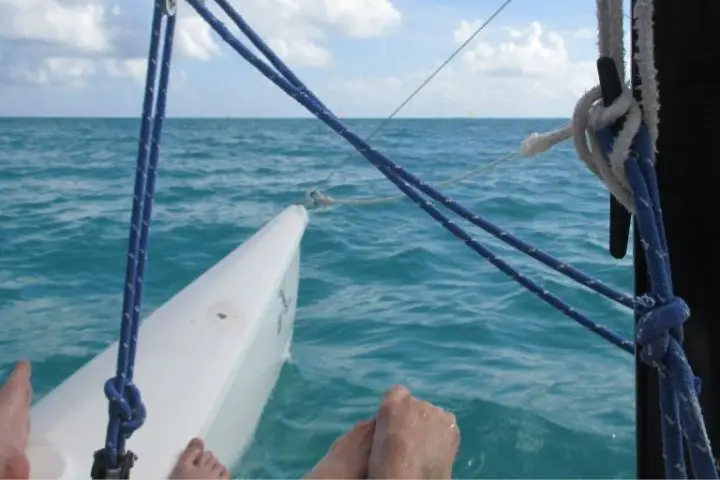Dreaming of quitting the 9-to-5 and sailing away into the sunset? Are you wondering if it’s an unattainable lifestyle of the rich and famous, or if it’s something that anyone can do?
Like any lifestyle, the cost of living on a sailboat can vary considerably depending on your choices. Where you want to keep the boat, whether you live at a resort-style marina or rough it out “on the hook,” and even how often you eat out all contribute to your monthly living expenses.
When researching the liveaboard lifestyle, one thing to consider first is that your actual lifestyle isn’t likely to change much just because you live on a boat. For example, your grocery budget will likely remain the same, assuming you’re not changing your geographic region very much. Likewise, if you’re keeping your vehicle, you’ll still have the same car expenses. So don’t assume that living aboard means instant money savings.
This concept has been promoted online by folks who want to embrace a minimalist lifestyle. If that’s your goal, you may find that living aboard saves you money. But most people do not save money by buying a boat.
Here’s a look at some of the costs that you can anticipate just to get started – to live on a sailboat, you’ll need to buy a sailboat, after all.
Table of Contents
- Initial Purchase Cost
- Estimating the Value of a Boat
- Buying New Versus Buying Used
- It Costs What It Costs
- Overhaul or Refit Costs
- Other Costs Related to Ownership
- Is The Cost Worth It?
Initial Purchase Cost
Did you know that there’s an easy way to make a small fortune when you buy a boat? It’s actually very easy—all you need to do is start with a very large fortune!
Jokes aside, boats are expensive, and they’re complicated to purchase. They’re built with a host of complex systems, and their construction and materials are foreign to non-boaters. Were you to inspect an old house, you’d immediately recognize things that are not as they should be—because you have been living in houses your entire life, after all. But on a boat, you are more or less clueless.
So the first step of buying a boat is to be careful and do your homework. Every boat purchase should be subject to a survey and sea trial—these are the minimum requirements for financing and insuring a vessel. Even if you are paying cash and planning to self-insure, a survey can save you thousands (maybe tens of thousands) of dollars.

Estimating the Value of a Boat
So you want to do a little dreaming and find your next boat. How do you find possible vessels? Most people surf on over to Yacht World. This is the largest international listing website of brokerage boats in the world, and it’s the best place to start. To be listed there, a boat must be listed with a broker. If you want to compare with for sale by owner boats, check out Sailboat Listings.
Of course, these sites are posting the asking price. The contracted price is harder to pin down, but like home prices, you can estimate that it is usually somewhere around 80 percent of the asking price. This is a generalization, but it usually holds true. Remember that for sale by owner vessels are “saving” themselves 10 percent in broker commissions, which may or may not be reflected in their asking prices.
The typical purchase process for boats progresses from the initial offer and contract to the survey and sea trial. The surveyor will figure out a market value for the vessel after inspection, much like the appraiser does during a home sale. If the surveyor’s value is considerably different than the contracted price, things will get renegotiated. No finance company is going to agree to finance a vessel for more than its surveyed market value. Obviously, this process protects buyers to some extent as well.
So, how does a dreamer figure out how much they should pay for a boat? Here are a few tips.
- The condition of the vessel, its year, make, and model determine its market value
- Consider engaging a “buyer’s broker” who can work with you and help you find the right boat and nail down the right offer to make
- Compare asking prices from the various online marketplaces and figure out the average price for a specific year, make, and model of vessel
- Installed equipment usually does not affect a vessel’s value as much as a seller would like to think it does
- Even on sailboats, the single most expensive piece of equipment on board is the engine—newer and lower time engines will boost value more than anything else
- Just because upgrades and improvements have been made does not mean that they have been done well or done professionally
- There is no way, other than by careful inspection, to find out if a boat has a damage or salvage history
- A boat’s geographic location greatly affects the market value—a boat in the Caribbean is worth less than a boat in the US
- Tax issues arise when purchasing a vessel overseas—expect to pay duty in your home country for importing it or taxes to keep it elsewhere
- For US buyers, taxes on vessels varies dramatically from state to state (some counties even levy annual personal property taxes on vessels)
- NADA Guides publishes an extensive list of used boat values, although their accuracy is somewhat limited.
Buying New Versus Buying Used
As you might expect, buying a boat is a little like buying a car. Should you buy new or used? You can save some money by buying used, but then you might face repairs and upgrades that a new boat wouldn’t need.
Still, brand new vessels need outfitting before they’re ready to go. Unlike cars, owners customize their boats with a host of systems and upgrades after leaving the factory. Boats seldom roll-off (float off?) the assembly line ready to cross an ocean. They usually need lots of extra work and gear to get them ready to go.
One disappointing fact that has been observed again and again is that new boats are seldom even seaworthy. Factories rush production and use some low-quality parts here and there. The first year of ownership is often spent troubleshooting and repairing brand new systems. This disappointing fact of life has played out repeatedly for owners of new boats, no matter the size or type of boat. Some manufacturers are better than others, but even the premium manufacturers have this issue.
Most experienced boaters will tell you that the sweet spot is a used boat that’s only about five years old. First, this means that the immediate loss of value after leaving the factory has occurred. Second, it also means that it has been used enough to work out all of the bugs, but the equipment is still new enough not to need replacement.
Once you get into vessels that are more than ten years old, significant components will need to be replaced. The mast’s standing rigging and the sails, as examples, usually have about a ten-year service life if they’re used a lot. The engine will probably last 15 to 20 years, depending on how many hours it has on it and how well it has been cared for. Unfortunately, many sailboat motors are severely neglected.

It Costs What It Costs
One last parting thought about boat values – it costs what it costs.
Let’s use an example. Say you became enamored with the Cabo Rico 38, a semi-custom full-keel cruiser with an outstanding bluewater reputation, stunning woodwork, and excellent construction quality. On Yacht World, there is a wide range of CR38s. Some need a lot of work and are priced under $50,000. Some are over $125,000, and these are meticulously maintained, and most have been repowered with new engines. The average cost of these boats is somewhere in between the two.
The moral of this lesson is simple—if you want to own a meticulously maintained CR38 with a newer engine, it will cost you over $120,000. Of course, you could pick up a “bargain” for $40,000—but you’ll wind up putting $80,000 or more into the boat to get it where you want it. Plus, it will take you a few years and a whole lot of aggravation to do so.
By this calculus, boats on the higher end of the price spread are the real values. If your goal is to go boating or liveaboard, these boats will get you on the water quicker and have fun faster. And in the end, you’ll have spent the same amount of money getting there as the person who bought that $40,000 boat and spends five years getting it to be as nice as the $120,000 boat you bought.
Many arguments can be made against this line of thinking. What if you do your own work? Many boat owners save tens of thousands of dollars by completing their own projects. But DIY boat work is often grueling and often still requires thousands in special parts and tools. Plus, this “savings” of this approach only works out if the person has the time to spare – remember that there’s a high opportunity cost when taking on major unpaid projects!
Overhaul or Refit Costs
So, now that you have some ideas of the initial purchase price, you have a rough idea of how much it will cost to get your hands on the boat of your dreams. But then you know it will need some work to make it liveaboard-ready—and maybe even more work if you want to travel extensively.
So how do you figure out how much that will cost. Before you dive into specific projects, it’s helpful to have a rough estimate in mind.
There is an old rule of thumb that has proven itself accurate many times over. If you have X dollars saved for the purchase of your vessel, you should only spend 50 percent of X on the initial purchase. You’ll then have half left over for overhauls, upgrades, repairs, and general enjoyment.
It’s easier said than done. When you’re first shopping, the $50,000 boats are going to look a lot nicer than the $25,000 boats. But if you can find a good value on a $25,000 boat that suits your needs, imagine how nice you can make it with $25,000 to spend on maintenance. So as hard as it is to follow, this rule really does work out in the end.
The rule doesn’t work well with the $5,000 junkyard boat, however. This vessel will require a lot more than another $5,000 to get back in shape—this $5,000 heap is a Project Boat.
“Project Boats”
The Project Boat is a much-debated topic amongst boaters. Are there bargains to be had out there if you’re willing to put in a little elbow grease? Or are they all just money pits, waiting to gobble up not only your hard-earned dollars but your patience and passion for boating, too?
The answer is, they are both out there.
Someone who has spent a decade or more on different boats can walk into a boatyard and pick out one particular sorry-looking wreck. They can purchase it for a song, put in a few months of hard work and new parts, and come out with a seaworthy and liveaboard-ready sailboat.
But one thing is sure—this story is the exception to the rule. Here’s what happens far more often. Someone falls in love with what a boat could be. They love its lines, its layout, the designer, or the model’s reputation. Whatever it is, they’re enamored with it, and they can see themselves sailing the Seven Seas on this beautiful vessel. So they purchase a wreck to find that dream boat—and you may have a clue as to how this story ends.
Inevitably, they have underestimated just how much work it will take to get the boat they’re purchased onto those Seven Seas. Sometimes it’s an underestimate of money—other times of the time it will take. Often deeper problems are found once the project is begun, and the project list grows exponentially.
So what’s the moral? If you’re new to boating, do not fall for a Project Boat. You want a boat that is floating, and that is in decent condition. It should not need any major repairs or upgrades. All of its systems should function and only need routine maintenance. Don’t worry–you’ll still have plenty of projects to do on a non-Project Boat.
All boats are projects. But if you see a boat actually labeled as a Project Boat, the best thing to do is to run away as fast as you can.
Other Costs Related to Ownership
Once you’ve got the boat in your hands, and you’ve done all the work to make it safe and livable, now comes the routine costs of ownership. Like owning a home, a boat has some built-in costs.
Repairs and Regular Maintenance
Boats break – a lot. Most owners say they spend about ten percent of their purchase price on maintenance annually. This number seems a bit high, but it depends on the sort of vessel you purchase and how old it is. The older the boat, the more likely you are to approach the ten-percent number.
Here’s an example of one significant expense that new boaters need to know about is bottom maintenance. The bottom of a liveaboard boat is coated with special paint to inhibit marine growth. The paint needs to be reapplied occasionally, sometimes as often as once a year.
Bottom paint is the perfect example of a boat maintenance project that will sneak up on you. First, you have to haul out the boat to do it, which usually means at least a few hundred dollars for the travel lift and yard fees. A few gallons of bottom paint and rollers will cost you another few hundred dollars.
It will probably take you two days on your own to apply two new coats of paint. It’s a messy job, but not unlike painting the sides of a house. Now, if you hire the yard to paint it for you, it will cost you another $80-100 per hour in labor.
So like all boat projects, you can spend two days of your own time and $500 or pay $2,000 for the yard to do everything.
The numbers are approximate and vary from place to place, but the point is that you can save money on things by doing them yourself, which reduces your cost of boating. If you’re paying the yard to do all the work all the time, it’s very easy to spend ten percent or more annually on repairs and maintenance.

Slip/Mooring
Slips for liveaboards are sometimes hard to find. If your goal is to live aboard your boat at a marina in a specific area, you should start shopping for slips before you buy the boat. You may discover that there are years-long waiting lists before you could achieve your dreams.
If you’re flexible and don’t mind moving around a little bit, you’ll have more luck. Some parts of the country are much more “liveaboard friendly.” And where you find more choices for liveaboard slips, you will likely find better slip prices.
For a 40-foot liveaboard boat, you can easily spend anywhere from $300 to $2,000 per month for a slip, simply depending on where you are based.
If you aren’t tied to a dock, costs can be lower. Some places have moorings available. In some places, it may be suitable to anchor or set up your own private mooring. You’ll need a dinghy for shore access. But if you can get by without shore power, living on a mooring or at anchor is more private and pleasant than being tied to a dock anyway.
Interested in liveaboard marinas in Florida, visit our guide!
Taxes
In the US, you’ll be responsible for sales and use tax on your vessel to your state. Most people pay the sales tax at purchase and are done. But if you bring a vessel into a different state and keep it there for a while (usually more than 90 days), that state may also collect use tax.
There are also a few municipalities that collect personal property tax on the assessed value of your boat as if it were a home. This is usually done at the county level and is only common in places where many liveaboards frequent. It’s worth ensuring that your county isn’t one of them before you get an unexpected tax bill.
Insurance
Like a car, you can ensure your vessel for its hull value or simply for liability coverage. Liability coverage doesn’t cost a lot and is the bare minimum you should have to operate—plan on spending a few hundred dollars per year.
You’ll also want to have some towing coverage. Both SeaTow and TowBoatUS offer services in the US. It costs about $150 per year to be a member. If you aren’t a member, a single tow bill can easily be well over $1,000.
Hull coverage may be harder to find on older vessels. As a rule of thumb, coverage runs about one percent of hull value annually—but this varies considerably depending on your location.
Hurricane-prone areas will have the highest insurance costs, especially for full hull value coverage. Many owners choose to spend hurricane season outside of the typical hurricane zone. Doing so can save thousands of dollars per year on insurance coverage. Most policies have a named storm deductible, as well.
Finally, insurance can be challenging to get for a new-to-you vessel. A lot depends on your prior boating experience. If you have none, you might have to spend time with a training captain before the insurance company will underwrite your coverage.
Fuel and Consumables
The actual operating costs of a sailboat are minimal. Even if you motor everywhere you go, sailboats tend to burn one gallon of diesel per hour or less. Most people don’t motor that much anyway–unless they’re going on a long trip on a windless day. Water and power are typically included in slip fees, although you may find places where either one is metered.

Is The Cost Worth It?
Boats are expensive, but crunching the numbers should make you feel better about it. Many people sell their homes to finance their dreams of a liveaboard sailboat. This provides a lump sum of cash that anyone can turn into a life on the water.
Keep in mind that boat life is neither cheap nor easy. If you’re looking for the cheapest accommodations possible, sailboats are about the hardest and most expensive way to go about doing it.
But if you’ve got a little cash squirreled away, and a life afloat is calling your name, there is no substitute for moving off of the land.

